
The Atari 2600 is a home video game console developed and produced by Atari, Inc. Released in September 1977 as the Atari Video Computer System, it popularized microprocessor-based hardware and games stored on swappable ROM cartridges, a format first used with the Fairchild Channel F in 1976. The VCS was bundled with two joystick controllers, a conjoined pair of paddle controllers, and a game cartridge—initially Combat and later Pac-Man. Sears sold the system as the Tele-Games Video Arcade. Atari rebranded the VCS as the Atari 2600 in November 1982 alongside the release of the Atari 5200.
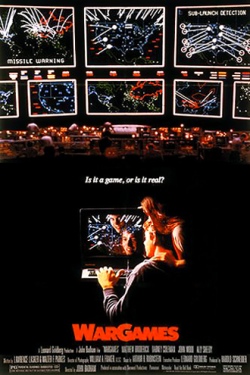
WarGames is a 1983 American techno-thriller film directed by John Badham, written by Lawrence Lasker and Walter F. Parkes, and starring Matthew Broderick, Dabney Coleman, John Wood and Ally Sheedy. Broderick plays David Lightman, a young computer hacker who unwittingly accesses a United States military supercomputer programmed to simulate, predict and execute nuclear war against the Soviet Union, triggering a false alarm that threatens to start World War III.

In nuclear strategy, a first strike or preemptive strike is a preemptive surprise attack employing overwhelming force. First strike capability is a country's ability to defeat another nuclear power by destroying its arsenal to the point where the attacking country can survive the weakened retaliation while the opposing side is left unable to continue war. The preferred methodology is to attack the opponent's strategic nuclear weapon facilities, command and control sites, and storage depots first. The strategy is called counterforce.
The video game crash of 1983 was a large-scale recession in the video game industry that occurred from 1983 to 1985, primarily in the United States. The crash was attributed to several factors, including market saturation in the number of video game consoles and available games, many of which were of poor quality. Waning interest in console games in favor of personal computers also played a role. Home video game revenue peaked at around $3.2 billion in 1983, then fell to around $100 million by 1985. The crash abruptly ended what is retrospectively considered the second generation of console video gaming in North America. To a lesser extent, the arcade video game market also weakened as the golden age of arcade video games came to an end.
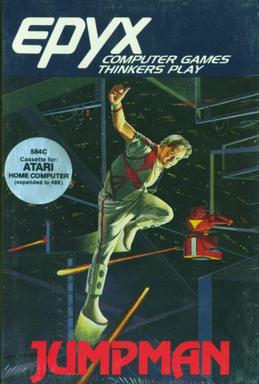
Jumpman is a platform game written by Randy Glover and published by Epyx in 1983. It was developed for the Atari 8-bit computers, and versions were also released for the Commodore 64, Apple II, and IBM PC compatibles.

Missile Command is a 1980 shoot 'em up arcade video game developed and published by Atari, Inc. and licensed to Sega for Japanese and European releases. It was designed by Dave Theurer, who also designed Atari's vector graphics game Tempest from the same year. The game was released during the Cold War, and the player uses a trackball to defend six cities from intercontinental ballistic missiles by launching anti-ballistic missiles from three bases.

Centipede is a 1981 fixed shooter arcade video game developed and published by Atari, Inc. Designed by Dona Bailey and Ed Logg, it was one of the most commercially successful games from the golden age of arcade video games and one of the first with a significant female player base. The primary objective is to shoot all the segments of a centipede that winds down the playing field. An arcade sequel, Millipede, followed in 1982.

Spy Hunter is a vehicular combat developed by Bally Midway and released for arcades in 1984. The game draws inspiration from the James Bond films and was originally supposed to carry the James Bond brand. The object of the game is to drive down roads in the technologically advanced "Interceptor" car and destroy various enemy vehicles with a variety of onboard weapons. Spy Hunter was produced in both sit-down and standard upright versions with the latter being more common. The game's controls consist of a steering wheel in the form of a futuristic aircraft-style yoke with several special-purpose buttons, a two-position stick shift, and a pedal used for acceleration.

Cabbage Patch Kids: Adventures in the Park is a 1984 action/platform game based on the Cabbage Patch Kids franchise. It is the first and only game in the Cabbage Patch Kids Adventures series.

Keystone Kapers is a platform game developed by Garry Kitchen for the Atari 2600 and published by Activision in 1983. The game involves a Keystone Cops-theme, with the player controlling police officer Kelly, who traverses the many levels of a department store, dodging objects to catch the escaped thief Harry Hooligan.
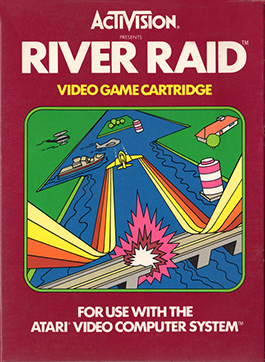
River Raid is a video game developed by Carol Shaw for the Atari Video Computer System and released in 1982 by Activision. The player controls a fighter jet over the River of No Return in a raid behind enemy lines. The goal is to navigate the flight by destroying enemy tankers, helicopters, fuel depots and bridges without running out of fuel or crashing.

Super Cobra is a horizontally scrolling shooter developed by Konami, originally released as an arcade video game in 1981. It was published by Konami in Japan in March 1981 and manufactured and distributed by Stern in North America on June 22. It is the spiritual sequel to the Scramble arcade game released earlier in 1981. Super Cobra contains eleven distinct sections, versus six in Scramble, and is significantly more difficult, requiring maneuvering through tight spaces early in the game.

In the history of video games, the second-generation era refers to computer and video games, video game consoles, and handheld video game consoles available from 1976 to 1992. Notable platforms of the second generation include the Fairchild Channel F, Atari 2600, Intellivision, Odyssey 2, and ColecoVision. The generation began in November 1976 with the release of the Fairchild Channel F. This was followed by the Atari 2600 in 1977, Magnavox Odyssey² in 1978, Intellivision in 1980 and then the Emerson Arcadia 2001, ColecoVision, Atari 5200, and Vectrex, all in 1982. By the end of the era, there were over 15 different consoles. It coincided with, and was partly fuelled by, the golden age of arcade video games. This peak era of popularity and innovation for the medium resulted in many games for second generation home consoles being ports of arcade games. Space Invaders, the first "killer app" arcade game to be ported, was released in 1980 for the Atari 2600, though earlier Atari-published arcade games were ported to the 2600 previously. Coleco packaged Nintendo's Donkey Kong with the ColecoVision when it was released in August 1982.

DEFCON is a real-time strategy game created by independent British game developer Introversion Software. The gameplay is a simulation of a global nuclear war, with the game's screen reminiscent of the "big boards" that visually represented thermonuclear war in films such as Dr. Strangelove, Fail-Safe, and especially WarGames.

Frogger II: ThreeeDeep! is a video game released in 1984 by Parker Brothers for the Apple II, Atari 8-bit computers, Atari 2600, Atari 5200, ColecoVision, Commodore 64, and IBM PC compatibles. It is a sequel to the 1981 Konami Frogger arcade video game and has similar gameplay.
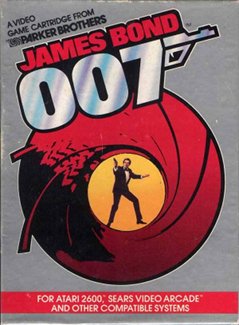
James Bond 007 is a horizontally scrolling shooter published in 1984 by Parker Brothers for the Atari 2600, Atari 5200, Atari 8-bit computers, Commodore 64, and ColecoVision. It was developed and published in Japan by Tsukuda Original for the SG-1000 under the title 007 James Bond. It was the first video game based on James Bond to be given a worldwide release.

Tutankham is a 1982 arcade video game developed and released by Konami and released by Stern in North America. Named after the Egyptian pharaoh Tutankhamun, the game combines a maze shoot 'em up with light puzzle-solving elements. It debuted at the European ATE and IMA amusement shows in January 1982, before releasing worldwide in Summer 1982. The game was a critical and commercial success and was ported to home systems by Parker Brothers.
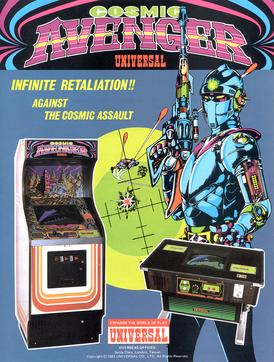
Cosmic Avenger is a scrolling shooter developed by Universal and released as an arcade video game in July 1981. It is part of the first wave shooters with forced horizontal scrolling which followed Konami's Scramble and Super Cobra from earlier in the year. It was released the same month as Vanguard. The final installment in Universal's Cosmic series, players take control of the Avenger space fighter and, as in Scramble, use bullets and bombs against enemy air and ground forces. The world is one continuous level made up of different areas.

The Dukes of Hazzard is a 1984 racing video game developed and published by Coleco for their ColecoVision game console and Coleco Adam computer. Elite Systems released a different game with the same title for the ZX Spectrum computer on February 23, 1985. Both versions are based on the television series of the same name.

Jennell Allyn Jaquays was an American game designer, video game artist, and illustrator of tabletop role-playing games (RPGs). Her notable works include the Dungeons & Dragons modules Dark Tower and Caverns of Thracia for Judges Guild; the development and design of conversions on games such as Pac-Man and Donkey Kong for Coleco's home arcade video game system; and more recent design work, including the Age of Empires series, Quake II, and Quake III Arena. One of her best known works as a fantasy artist is the cover illustration for TSR's Dragon Mountain adventure.



















